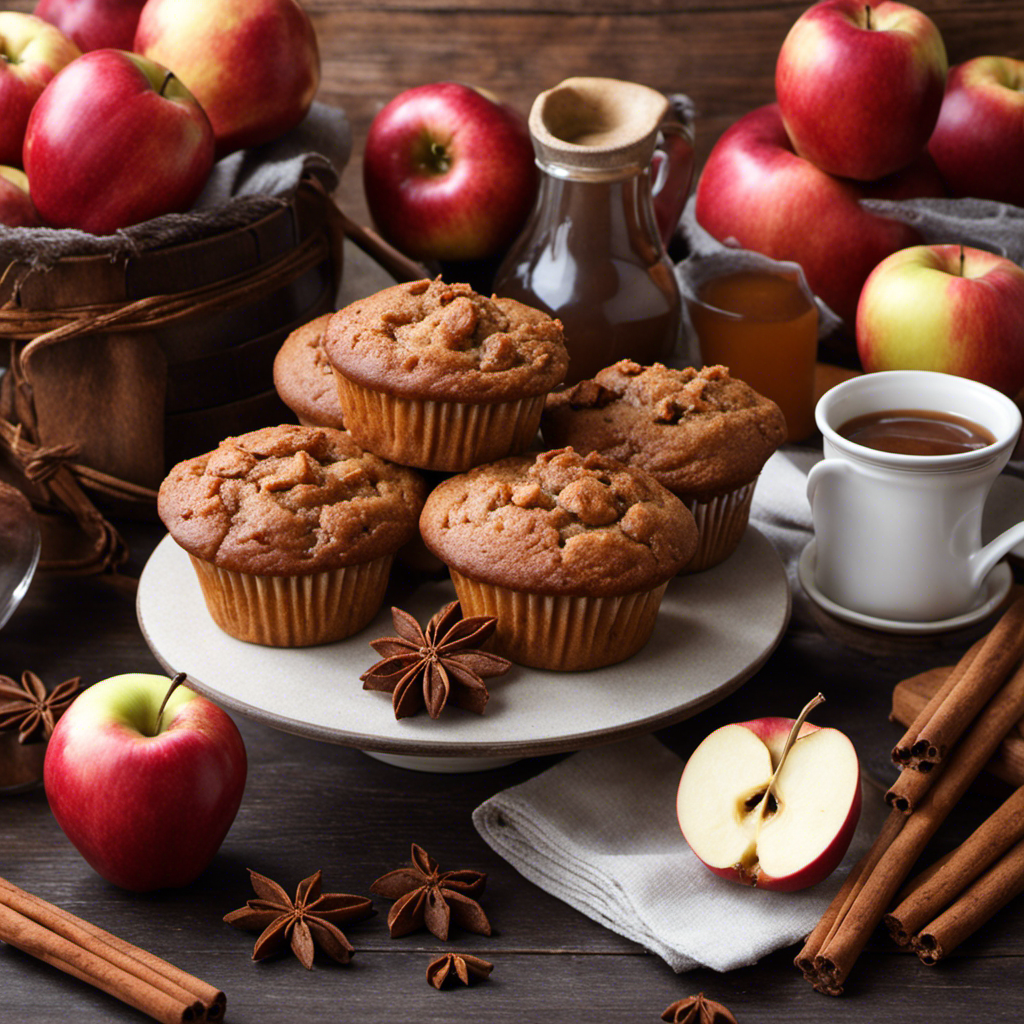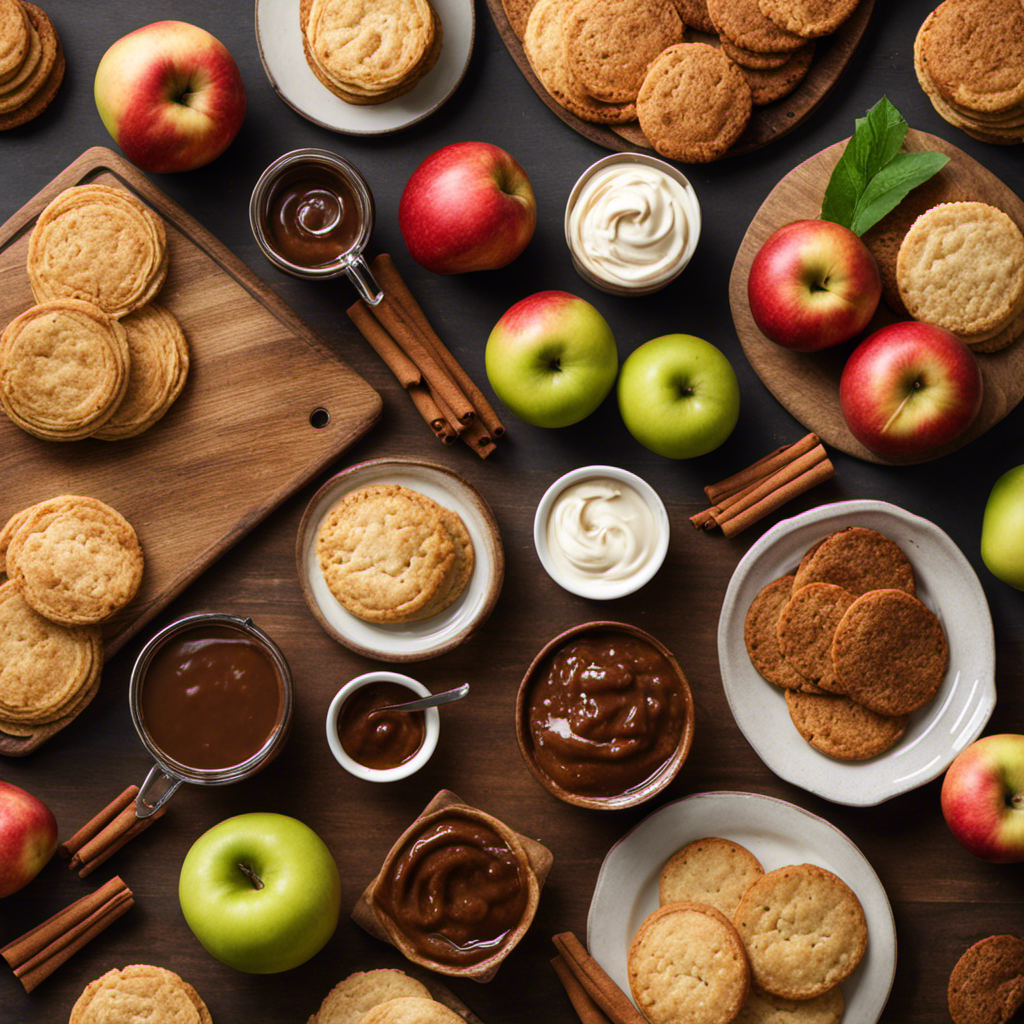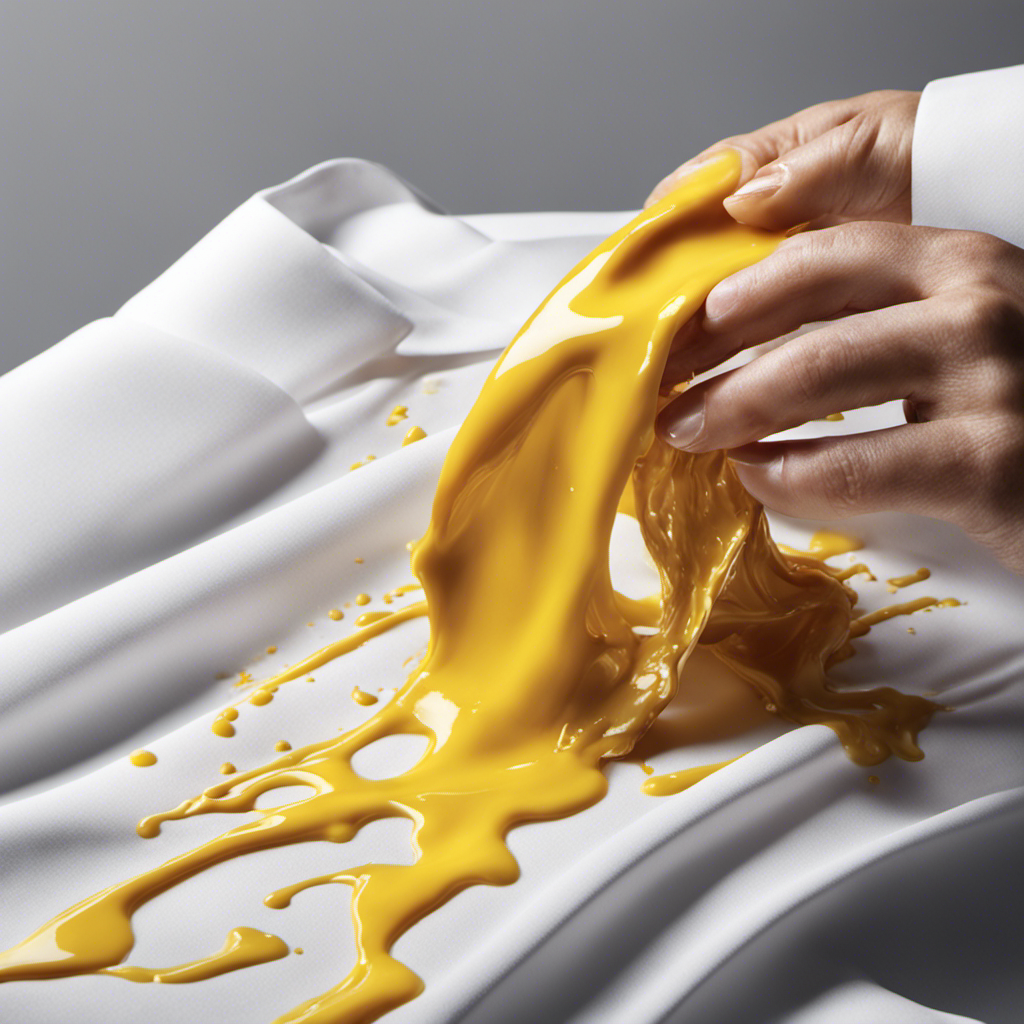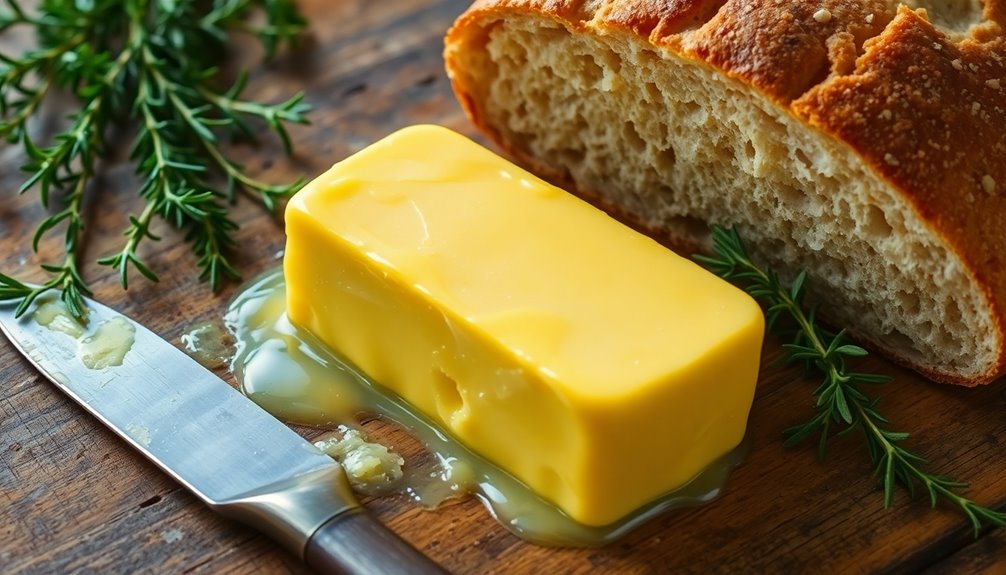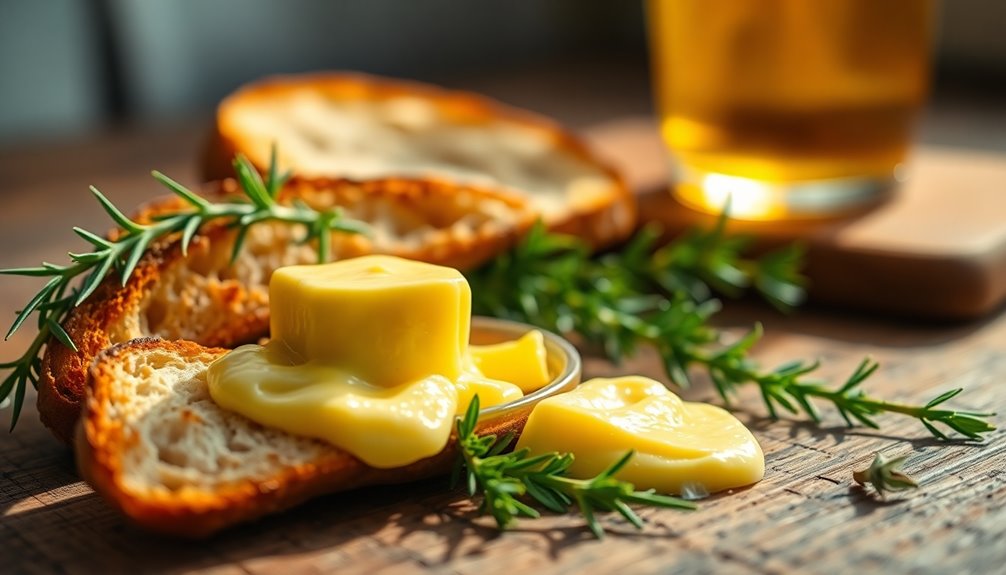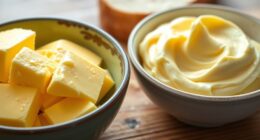You have a jar of apple butter in your pantry, patiently waiting for its time to shine. I’m here to inform you, my friend, that there are endless possibilities!
From luscious breakfast spreads to delectable desserts, apple butter can add a burst of flavor to all your culinary creations.
In this article, we’ll explore the many ways you can use apple butter to elevate your meals and satisfy your taste buds.
Get ready to embark on a delicious journey with this versatile condiment.
Key Takeaways
- Apple butter can be used in various ways in cooking, such as adding flavor and moisture to baked goods, as a spread on toast or bagels, as a topping for pancakes or waffles, and as a filling for pastries or turnovers.
- Apple butter is a healthier alternative to spreads like butter or syrup and can be used as a substitute for butter or oil in baking recipes. It is packed with vitamins, minerals, and dietary fiber, and offers various health benefits such as improved digestion, boosted immune system, and heart health promotion.
- Apple butter can be used as a delicious and satisfying snack or appetizer when spread on whole wheat crackers, incorporated into quick appetizers, mixed with cream cheese and spread on mini toasts, or swirled into yogurt.
- Apple butter can be paired with unexpected flavors like bacon or blue cheese to create unique taste sensations. The combination of apple butter and bacon offers a perfect balance of sweet and savory flavors, while tangy blue cheese pairs wonderfully with rich and fruity apple butter.
Breakfast Ideas
You can spread apple butter on toast or pancakes for a delicious breakfast treat. This sweet topping is not only tasty, but it also provides a healthy alternative to other spreads like butter or syrup.
The smooth and creamy texture of apple butter adds a burst of flavor to your morning meal. Imagine the warm, toasty bread or fluffy pancakes topped with a generous dollop of apple butter, melting and blending with the warmth. The sweetness of the apple butter perfectly complements the savory flavors of breakfast.
If you’re looking for a nutritious and satisfying way to start your day, give apple butter a try.
Now let’s move on to some mouthwatering baking recipes that incorporate this delightful ingredient.
Baking Recipes
When baking recipes, it’s great to have apple butter on hand as a flavorful ingredient. Not only does it add a sweet and tangy taste to your baked goods, but it also offers some health benefits.
Here are three reasons why apple butter is a great addition to your baking adventures:
-
Recipe Substitutions: Apple butter can be used as a healthier alternative to butter or oil in many recipes. It adds moisture and richness, while reducing the overall fat content.
-
Health Benefits: Apple butter is packed with vitamins and minerals, as well as dietary fiber. It can help improve digestion, boost your immune system, and promote heart health.
-
Flavor Enhancer: The natural sweetness of apple butter adds depth and complexity to your baked goods. It pairs well with spices like cinnamon, nutmeg, and cloves, creating a delightful aroma and taste.
With these benefits in mind, let’s explore some delicious snack options that incorporate apple butter.
Snack Options
One option for a tasty snack is to spread apple butter on whole wheat crackers for a satisfying and flavorful treat. The combination of the sweet and tangy apple butter with the crunch of the crackers creates a delightful contrast of textures and flavors. But apple butter can be used for more than just snacking. It can also be incorporated into quick appetizers or used as an afternoon pick me up. For example, you can mix apple butter with cream cheese and spread it on mini toasts for a simple and delicious appetizer. Or, you can swirl apple butter into yogurt for a refreshing and energizing afternoon snack. The possibilities are endless when it comes to using apple butter in creative and tasty ways!
| Quick Appetizers | Afternoon Pick Me Ups |
|---|---|
| Apple Butter and Cream Cheese Mini Toasts | Apple Butter Yogurt Swirl |
| Apple Butter and Brie Crostini | Apple Butter Smoothie |
| Apple Butter and Cheddar Quesadillas | Apple Butter Granola Parfait |
Dessert Inspirations
Are you looking to take your desserts to the next level?
In this discussion, we will explore unique flavor combinations, recipe adaptations and variations, as well as apple butter pairings.
Get ready to discover exciting new tastes and techniques that will elevate your sweet treats to a whole new level of deliciousness.
Whether it’s experimenting with unexpected flavors or finding the perfect accompaniment for your apple butter creations, this discussion will inspire you to get creative in the kitchen and impress your taste buds.
Unique Flavor Combinations
You can try pairing apple butter with unexpected flavors like bacon or blue cheese for a unique taste sensation. The sweet and savory combination of apple butter and bacon creates a perfect balance of flavors. The smoky and salty notes of the bacon complement the sweetness of the apple butter, resulting in a mouthwatering treat.
Similarly, the tangy and creamy blue cheese pairs wonderfully with the rich and fruity apple butter. Spread this delicious combination on a toasted baguette or use it as a topping for grilled burgers to elevate your culinary experience.
Apple butter offers a versatile option for those looking for condiment alternatives that go beyond the usual choices. So go ahead, experiment with these unexpected flavor combinations and delight your taste buds.
Recipe Adaptations and Variations
Try experimenting with different ingredients and flavors to adapt and vary your recipes for a unique culinary experience. Recipe substitutions and cooking techniques can completely transform a dish, giving it a new twist and flavor profile.
For example, you can substitute apple butter for other sweeteners like honey or maple syrup in baking recipes. Its rich and tangy taste adds depth and complexity to your dishes. You can also use apple butter as a marinade or glaze for meats, adding a sweet and savory element to your proteins.
Don’t be afraid to get creative and try new combinations. The possibilities are endless when it comes to adapting recipes with apple butter. Now, let’s explore some delicious apple butter pairings that will take your culinary creations to the next level.
Apple Butter Pairings
Now that you’ve learned about different ways to adapt and vary apple butter recipes, it’s time to explore some exciting apple butter pairings. Get ready to tantalize your taste buds with these delicious ideas:
-
Apple Butter Cocktails: Take your favorite cocktails to the next level by incorporating apple butter. Whether it’s a refreshing apple butter sangria, a cozy apple butter hot toddy, or a tangy apple butter margarita, the possibilities are endless. The rich, sweet, and slightly spiced flavors of apple butter will add a delightful twist to your favorite libations.
-
Apple Butter Marinades: Elevate your grilling game with apple butter marinades. The natural sweetness of the apple butter combined with savory ingredients like garlic, soy sauce, and Worcestershire sauce creates a mouthwatering glaze for meats, poultry, or even tofu. Let the flavors meld together and enjoy tender, succulent dishes bursting with flavor.
-
Savory Dishes: But don’t stop there! Apple butter is a versatile ingredient that can enhance a wide range of savory dishes. From glazing roasted vegetables to adding depth to stews and soups, or even as a condiment for sandwiches and burgers, the possibilities are endless.
Now that you’ve explored apple butter pairings, let’s dive into the world of savory dishes.
Savory Dishes
Savory dishes can be enhanced with the addition of apple butter. Whether you’re looking to add a touch of sweetness or a burst of flavor, apple butter can be a versatile ingredient in your kitchen.
One way to incorporate apple butter into your savory dishes is by using it as a marinade. The natural sweetness of the apple butter pairs well with meats like chicken, pork, or even beef. Simply mix apple butter with some garlic, soy sauce, and your preferred spices, and let your meat marinate for a few hours before cooking.
Another delicious option is to use apple butter as a glaze for meats. Brush it onto your roasted chicken or grilled pork chops for a caramelized, tangy finish.
With apple butter, your savory dishes will never be the same.
Now, let’s move on to some homemade gift ideas using apple butter.
Homemade Gift Ideas
Looking for unique ways to package your homemade gifts?
In this discussion, we’ll explore creative packaging ideas that will make your gifts stand out.
From personalized labels and DIY gift boxes to eco-friendly wrapping alternatives, we’ve got you covered.
Get ready to impress your loved ones with thoughtful and beautifully packaged homemade gifts.
Creative Packaging Ideas
If you’re hosting a party, why not try using mason jars to package your apple butter? Not only will it keep your delicious spread fresh, but it also makes for a charming and unique presentation.
Here are three creative packaging ideas to make your apple butter gifts extra special:
-
Ribbon and Tag: Tie a colorful ribbon around the neck of the mason jar and attach a personalized gift tag. You can write a heartfelt message or include the recipe for your apple butter to make it even more thoughtful.
-
Fabric Cover: Cut a piece of fabric into a circle slightly larger than the jar lid. Secure it with a rubber band or twine and add a cute button on top for a rustic touch. This DIY wrapping idea adds a cozy and homemade feel to your gift.
-
Chalkboard Label: Paint the lid of the mason jar with chalkboard paint and let it dry. Once dry, use chalk to write the recipient’s name or a fun message on the lid. It’s a fun and reusable way to personalize your apple butter gifts.
With these creative packaging ideas, your apple butter gifts are sure to impress and delight your guests.
Personalized Homemade Gifts
Now that you have some creative packaging ideas for your apple butter, let’s explore another exciting aspect: personalized homemade gifts. DIY projects are a wonderful way to show your loved ones how much you care. By creating personalized crafts, you can add a unique touch to your gifts that will be cherished for years to come.
To give you some inspiration, here is a table showcasing four DIY projects that you can easily make at home:
| Project | Description |
|---|---|
| Customized Mugs | Use paint pens to write a personal message or draw a design on plain mugs. |
| Photo Collage Frame | Create a collage using memorable photos and frame it for a heartfelt gift. |
| Handmade Jewelry | Make bracelets or necklaces using beads and charms that reflect the recipient’s personality. |
| Personalized Candle | Decorate a plain candle with the recipient’s initials or a special message using wax or markers. |
These personalized crafts will not only showcase your creativity but also make your loved ones feel truly special. So, get ready to unleash your artistic side and create heartfelt gifts that will leave a lasting impression.
Conclusion
So now you know all the amazing ways you can use apple butter in your kitchen! From breakfast to dessert, there’s no shortage of delicious options to explore.
Whether you spread it on toast, swirl it into muffin batter, or use it as a glaze for roasted meats, apple butter adds a rich and comforting flavor to any dish.
In fact, did you know that apple butter has been enjoyed for centuries? Its history dates back to colonial America, where it was a staple in many households.
So give it a try and discover the timeless appeal of this versatile ingredient.
